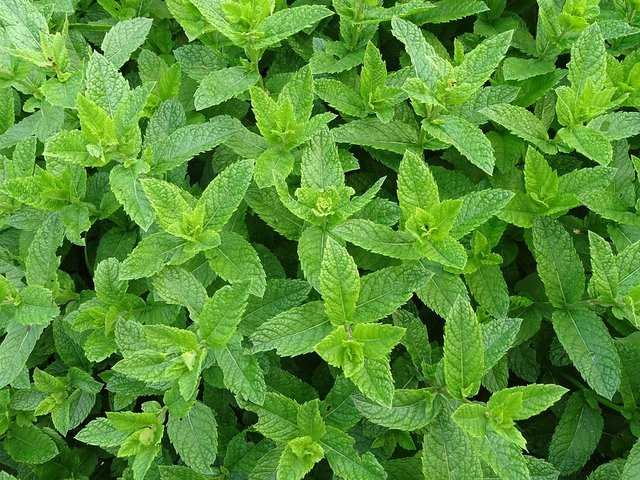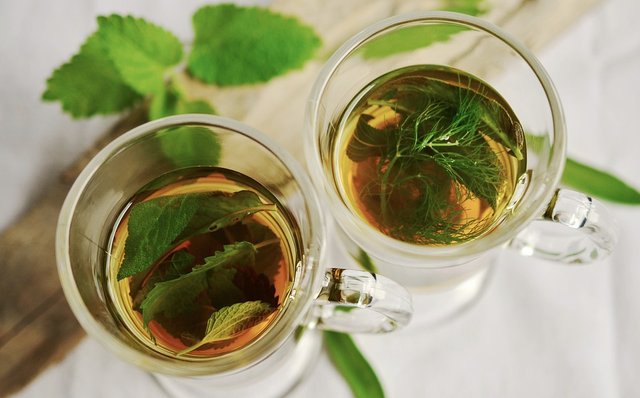THE URBAN FORAGING HANDBOOK: MINT, for the ThursdayGreen ColorChallenge
Welcome to the Urban Foraging Handbook.
Believe it or not, there is free food growing just up the street from you. You only need to know where to look. I will focus on the foods that grow in most areas of the world, aside from the extremes of hot and cold, so that you have the likeliest chance of finding the plant in your area. The ColorChallenge initiated by @kalemandra focuses on the color green for every Thursday and what better way to celebrate this color than by examining the lush, growing, GREEN food that exists all around us.
So, for this week I'd like to continue with the herb mint.
 Source
SourceYou all may be familiar with mint tea and mint chocolate chip ice cream (mmm!), so now I will show you how to find and use the actual plant. Even if you don't like the flavor, the leaves can be pressed for oil and the flowers add an aromatic sweet cream smell to the classic mint bite. Here are some basic recipes/uses for mint that can help make your day better.
The Mint Tea Effect:
 Source
SourceMint tea has two effects on the body, stimulating and calming. I know that these may sound contradictory, but I will explain.
Traditionally mint tea is given with a spoonful of honey to calm the body and brain. It is a great hot drink for before bed as the mint does not have any caffeine in it. The mint is soothing and the honey helps clear allergies so that there are no stuffy nose or congested chest problems while trying to fall asleep.
Conversely a sprig of mint leaves and a slice of lemon in your cold water bottle for the day is a great energizer and will give you an extra step of energy every time you take a drink. Mint actually opens up the capillaries so that you can take in more oxygen.
 Source
SourceIf you really just hate the taste of mint, then you can get a great effect from the oil instead. For headaches apply the oil in soothing massage circles to the temples.
Mint oil rubbed into the doorframe and windowsills will deter insects.
I personally like to throw a few leaves into the litter box; every time the cats move the leaves around in the litter it releases a minty odor. Sprinkle a spoonful of baking soda to negate the strong urine odor and you have litter that's better than the expensive perfumed stuff.
For anything wild that you decide to eat I recommend that you take a piece and rub a small part of your inner forearm with the "sap" that appears when the plant is broken open. You never know what kind of reaction you may have to a new food. If you arm swells and itches, chances are that your mouth will do the same and your stomach will upset.
Well, I hope you all go out and at least look at the weeds differently!
If this information was helpful or interesting to you, please upvote and repost so that we can reach as many people as possible. Ignorance breeds hunger and when there is so much natural food to be found and eaten its a shame that people go hungry.
Did our ancestors go to the grocery store? I think not!
Until next time my friends,
@jennswall
website, twitter, facebook

Do not steal, re-use, copy or distribute this image without my consent.
(Re-steeming is fine.)
(Upvoting is also ok)




What is the most common wild mint species near where you live?
In Ireland our most common "wild" mint is Mentha aquatica, really easy to find if you know where to look. Basically it loves wet damp soggy ground, so if there's a nearby stream or a bit of boggy ground you're likely find a big healthy patch of the stuff.
It has a strong distinctive peppermint-like fragrance and can be used as a flavouring in salads or cooked foods. Although it might be that the leaves are too pungent for some people to use as a flavouring. Also a herb tea can be made from the leaves.
There are other mint species as well but they are must less frequently found than Mentha aquatica.
Here too, the mint tends to grow in the same areas, near streems, in low laying areas for ground and near water sources. Here we have a lemon mint that grows very well and then the classic Spanish Hierba Buena or "the good herb" which I believe is spearmint, from the flavor and shape of the leaves.
A lemon mint? That sounds tasty. I guess obviously I forgot to point out that many people will plant mint into their gardens which could be a variety of types, but as the title said foraging I was thinking about the proper wild varieties. I suppose you're somewhere in the States??
Actually we're in southern Spain, but the plant variety here is similar to the Midwest "desert" regions in the States. The wild "lemon-balm" mint that we can find here is very light, but goes great with a couple leaves crushed into a cup with a spoonful of honey and hot water. Very refreshing. More so when you brew it hot and then leave it to cool in the refrigerator.
Oh yum, I bet that's refreshing in a Spanish summer!
Oh yeah, I actually carry around bottles of water with mint or lemon in it, ginger slices, green tea, apple slices or cucumber slices. They give a really great change.
Clearly a witch of sorts ;P (from one witch to another!)
Merry meet!